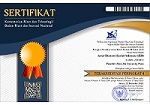Factors Influencing Interest in Muslim Entrepreneurs as Financing Partners for Sharia P2P Lending
Abstract
This study aims to determine the factors that influence the interest of Muslim entrepreneurs in Sharia P2P lending. The determinant factor used is perceived ease of use, the subjective norm in Muslim circles, perceived usefulness, knowledge about riba, and review from the experience of financing partners. This study used a quantitative method tested by structural equation model (SEM) analysis techniques. Data were processed using SmartPLS 3.0 software. Data was obtained through an online questionnaire. Respondents who were used by UMKM, UKM, or startup business actor, Muslim, and had attended online classes and seminars on Sharia fintech. The number of respondents used was 90. The results show there were three predictors, perceived ease of use, the subjective norm in Muslim circles, and perceived usefulness that did not have a significant effect on behavioral intention, but two predictors of knowledge about riba and review from the experience of financing partners have a significant influence on behavioral intention
Keywords
Full Text:
PDFReferences
Abdul Khalek, A., Syed Ismail, S. H., & Mohamad Ibrahim, H. (2017). a Study on the Factors Influencing Young Muslims’ Behavioral Intention in Consuming Halal Food in Malaysia. Jurnal Syariah, 23(1), 79–102.https://doi.org/10.22452/js.vol23no1.4
Aji, H. M., Berakon, I., & Riza, A. F. (2020). The effects of subjective norm and knowledge about riba on intention to use e-money in Indonesia. Journal of Islamic Marketing, 12(6), 1180–1196. https://doi.org/10.1108/JIMA-10-2019-0203
Achsan, T. (2017). Examining The Impacts of Religiosity, Attitude, and Subjective Norm Toward Intention to Purchase Halal Food: A Study on Indonesian Muslim Consumers.
Aji, H. M., Berakon, I., & Riza, A. F. (2020). The effects of subjective norm and knowledge about riba on intention to use e-money in Indonesia. Journal of Islamic Marketing, 12(6), 1180–1196. https://doi.org/10.1108/JIMA-10-2019-0203
Ajzen, I. (2002). Perceived behavioral control, self-efficacy, locus of control, and the theory of planned behavior. Journal of Applied Social Psychology, 32(4), 665–683. https://doi.org/10.1111/j.1559-1816.2002.tb00236.x
Amalia, S. N. A. (2018). Faktor-Faktor Yang Mempengaruhi Minat Individu Terhadap Financial Technology Syariah Paytren Sebagai Salah Satu Alat Transaksi Pembayaran: PendekatanTechnology Acceptance Model dan Theory Of Planned Behavior. Jurnal Ekonomi & Keuangan Islam, 9(1), 65–79.
Ansari, A., & Anwari, M. K. (2022). Model Penerimaan Teknologi ( TAM ) Terhadap Intensi Menggunakan. Jurnal Produktivitas, 9, 236–241.
Bertagnolli, C. (2011). Delle vicende dell’agricoltura in Italia; studio e note di C. Bertagnolli. Delle Vicende Dell’agricoltura in Italia; Studio e Note Di C. Bertagnolli., 13(3), 319–340. https://doi.org/10.5962/bhl.title.33621
Bertsch, C., Hull, I., & Zhang, X. (2016). Monetary Normalizations and Consumer Credit: Evidence from Fed Liftoff and Online Lending. Ssrn, 319. https://doi.org/10.2139/ssrn.2780418
A Proposed Model and Measurement Instrument for The Formation of IS Satisfaction: The Case of End-User Computing Satisfaction, (2006).
Daragmeh, A., Lentner, C., & Sági, J. (2021). FinTech payments in the era of Covid-19: Factors influencing behavioral intentions of “Generation X” in Hungary to use mobile payment. Journal of Behavioral and Experimental Finance, 32, 100574. https://doi.org/10.1016/j.jbef.2021.100574
Darmansyah, Fianto, B. A., Hendratmi, A., & Aziz, P. F. (2020). Factors determining behavioral intentions to use Islamic financial technology: Three competing models. Journal of Islamic Marketing, 12(4), 794–812. https://doi.org/10.1108/JIMA-12-2019-0252
Davis, F. D. (1989). Perceived usefulness, perceived ease of use, and user acceptance of information technology. MIS Quarterly: Management Information Systems, 13(3), 319–339. https://doi.org/10.2307/249008
Demirguc-Kunt, A., Klapper, L., Singer, D., Ansar, S., & Hess, J. (2018). The Global Findex Database 2017: Measuring Financial Inclusion and the Fintech Revolution. In The Global Findex Database 2017: Measuring Financial Inclusion and the Fintech Revolution. https://doi.org/10.1596/978-1-4648-1259-0
Ghozali, I. (2006). Aplikasi Analisis Multivariate dengan Program SPSS. Badan Penerbit Universitas Diponegoro.
Ghozali, I., & Latan, H. (2015). Partial Least Squares Konsep, Teknik, dan Aplikasi Menggunakan Program Smartpls 3.0 untuk Penelitian Empiris. Badan Penerbit Universitas Diponegoro.
Hair, J. F., Black, W. C., Babin, B. J., Anderson, R. E., & Tatham, R. L. (2006). Multivariate Data Analysis (Sixth Edition; Pearson Internation Edition).
Holbrook, M. B., & Hirschman, E. C. (1982). The Experiential Aspects of Consumption: Consumer Fantasies, Feelings, and Fun. Journal of Consumer Research, 9(2), 132. https://doi.org/10.1086/208906
Johan, Z. J., Hussain, M. Z., Mohd, R., & Kamaruddin, B. H. (2020). Muslims and non-Muslims intention to hold Shariah-compliant credit cards: a SmartPLS approach. Journal of Islamic Marketing, 12(9), 1751–1785. https://doi.org/10.1108/JIMA-12-2019-0270
Jing, P., Huang, H., Ran, B., Zhan, F., & Shi, Y. (2019). Exploring the factors affecting mode 13 choice intention of the autonomous vehicle based on an extended theory of planned behavior-A case study in China. Sustainability (Switzerland), 11(4), 1–20. https://doi.org/10.3390/su11041155
Kang, J. (2018). Mobile payment in Fintech environment: trends, security challenges, and services. Human-Centric Computing and Information Sciences, 8(1). https://doi.org/10.1186/s13673-018-0155-4
Lova, E. F. (2021). Financial Technology Peer To Peer Lending Syariah: Sebuah Perbandingan Dan Analisis. Jeblr, 1(2), 29–41.
Mohd Thas Thaker, M. A., Mohd Thas Thaker, H., & Allah Pitchay, A. (2018). Modeling crowd funders behavioral intention to adopt the crowdfunding-waqf model (CWM) in Malaysia: The theory of the technology acceptance model. International Journal of Islamic and Middle Eastern Finance and Management, 11(2), 231–249. https://doi.org/10.1108/IMEFM-06-2017-0157
Nursiah. (2017). Pengaruh Perceived Ease of Use dan Perceived Usefulness Terhadap Behavior Intention To Use. JESIK (Jurnal Elektronik Sistem Informasi Dan Komputer, 3(2), 39–47.
Pişkin, M., & Kuş, M. C. (2019). Islamic Online P2P Lending Platform. Procedia Computer Science, 158, 415–419. https://doi.org/10.1016/j.procs.2019.09.070
Rogers, K. L. dan E. (1981). Communication Networks: Toward a New Paradigm Research.
S, N., Syahrial Haq, H., Dimyati, K., & Setiaji, B. (2018). Norm Characteristics of Islamic Banking in Indonesia on Murabahah Instrument Towards Beyond Banking. Jurnal IUS Kajian Hukum Dan Keadilan, 6(3), 352. https://doi.org/10.29303/ius.v6i3.581
Sari, S., Layli, M., Marsuking, M., & ... (2023). Pengaruh Profitabilitas, Likuiditas, Leverage, Kebijakan Dividen dan Ukuran Perusahaan terhadap nilai perusahaan pada perusahaan terdaftar di Jakarta Islamic Ekonomi Syariah https://ejournal.almaata.ac.id/index.php/JESI/article/view/2733%
Saputra, B., & Riza, A. F. (2023). Adopsi Payment Gateaway Shariah : Peran Pengetahuan Riba Sebagai Moderasi. Journal of Business Management and Islamic Banking, 02(01), 1–16.
Sarawatari, Y. A., Hasan, A., & Laili, I. (2021). Pengaruh Persepsi Risiko, Ekspektasi Return, Behavioral Motivation Dan Kemajuan Teknologi Terhadap Keputusan Investasi Di Peer To Peer Lending Syariah. In HUMAN FALAH: Jurnal Studi Ekonomi dan Bisnis Islam (Vol. 8, Issue 2). https://doi.org/10.30829/hf.v8i2.9815
Setyawati, R. E. (2020). Pengaruh Perceived Usefulness, Perceived Ease of Use Terhadap Behavioral Intention to Use Dengan Attitude Towards Using Sebagai Variabel Intervening. Jurnal Ekobis Dewantara, 3(1), 39–51.
Sugiyono. (2005). Metode Penelitian Kuantitatif, Kualitatif, dan R&D. Alfabeta.
Syaebani, M. I., Madina, A., & Astrini, M. R. (2020). Past Behaviour, Conscientiousness Personality, and Attitude Toward Engagement in Workplace Affairs. International Research Journal of Business Studies, 13(3), 249–267. https://doi.org/10.21632/irjbs.13.3.249-267
Thanker, H. M. T., Qoyyum, A., Subramaniam, N. R., & Hussain, H. I. (2022). Cashless Society, E-Wallets, and Continous Adoption. International Journal of Finance and Economics. https://doi.org/https://doi.org/10.1002/ijfe.2596
Ulfatin, N. (2022). Metode Penelitian Kualitatif di Bidang Pendidikan: Teori dan Aplikasinya. Media Nusa Creative (MNC Publishing).
Venkatesh, V. and Davis, F. D. 2000. The Theoretical Extention of The Technology Acceptance Model: Four Longitudinal Field Studies. Management Science, 46 (2): 186-204.
Wiharjo, B., & Hendratmi, A. (2019). Persepsi Penggunaan Zakat Online Di Indonesia. Jurnal Ekonomi Syariah Teori Dan Terapan, 6 (2)(July), 331-343.
Yuniarti, V. S. (2015). Perilaku Konsumen: Teori Dan Praktik. Aksara Penulis, Bandung
Y.H. Lee, Y.C. Hsieh, C. N. H. (2011). Adding Innovation Diffusion Theory to the Technology Acceptance Model: Supporting Employees’ Intentions to Use E-Learning Systems. Educating Technology & Society.
DOI: http://dx.doi.org/10.21927/jesi.2023.13(2).210-224

This work is licensed under a Creative Commons Attribution-ShareAlike 4.0 International License.












